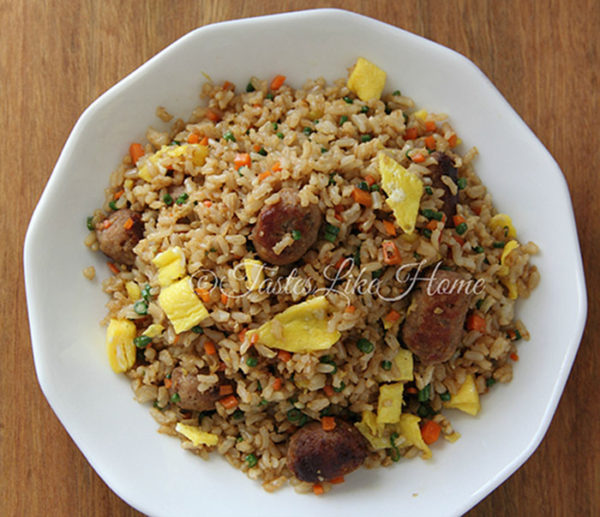Hi Everyone,
Today, January 7, marks 10 years to the date that the first Tastes Like Home column was published in this newspaper. The success of this column belongs to you the reader.
This column started out as an expression of appreciation of Guyanese food, a couple of years later, that gratitude included Caribbean cuisine with an eventual and obvious celebration of food in general. If you ask me today what Tastes Like Home is about, I’d say that it is still those things, but is also seeks to passionately educate by providing extensive information on ingredients, through periodic primers for certain dishes, and more recently with the What’s Cooking series.
 For me, the education has been both ways, there is so much that I have learnt from you. Through your requests, queries, tips and advice I have experimented, tested, and tasted many things. There are many things, though I had eaten them before, and was familiar with the taste, I personally had never made (cooked) them, so it was always exciting making stuff on my own for the first time and sharing my experiences with you.
For me, the education has been both ways, there is so much that I have learnt from you. Through your requests, queries, tips and advice I have experimented, tested, and tasted many things. There are many things, though I had eaten them before, and was familiar with the taste, I personally had never made (cooked) them, so it was always exciting making stuff on my own for the first time and sharing my experiences with you.
I remember back in 2010 when I received a recipe request for Peera (Indian-style soft milk fudge) and set about making it from scratch (meaning not with condensed milk or with the use of a microwave). It took me 13 hours over a period of 2 days, 3 litres of milk and 2¼ cups of sugar to get it right. I had made 3 batches before it finally came out the way it was meant to.
I learnt to make Pot Bakes, brewed Mauby making it from the bark, and received a great tip on making plantain Foo-foo by adding a turning plantain to the mix so that the Foo-foo holds its shape when formed. I made Kalounjie (stuffed karaila) on my own for the first time in 2007. Khichri (thick soupy dish of rice and dhal), Shine rice and Sugar roti are foods that took us down memory lane. These are foods we should always hold dear.
Looking back, what was true 10 years ago is still true today – we voraciously consume food media but that consumption does not translate into the actual cooking and eating of homemade meals. We’ve seen the steady, steep rise of food importation bills, the erection of more fast food establishments, and palettes that crave food products rather than actual food. This is true not only in Guyana but the region as a whole. There is much that needs to be done to address our many food issues but at the same time not all is lost. There are signs, albeit small ones, of hope (never mind that in some cases it had to take outside influence to make us sit up and listen/eat).
Coconut oil has made a huge comeback, heck we’re even talking about it much the same way that olive oil is propagandized – virgin, extra virgin, light and regular. Look at how saijan has become the new super food… slap on its other name, Moringa, and you suddenly find yourself paying more money for the vegetable and leaves. We’ve gotten “permission” to eat pears (avocados), and ground provision flours – cassava, sweet potato and breadfruit – are now hot-ticket items with premium price tags. They trendily sit on the shelves of gourmet food stores, high-end groceries, health shops, and can be found in the aisles that sell only organic foods. To all of this I say, repeating myself yet again – we need to get back to eating more of our own foods.
Speaking of repeating myself, as we embark on a new year, that window of time where people seem a little more open to ways of change, improving our lives, especially by adjusting our eating habits, permit me to share a few excerpts of past columns with the hope that you find them useful, or at the least, reflect upon.

Photo by Cynthia Nelson
On taste
Do you taste when you eat? Can you discern what it is that you’re eating and drinking when you consume food and beverages? Can you tell if you are eating lamb instead of beef, or if the piece of chicken is the breast meat instead of the thigh meat? Do you know what cherry juice tastes like or are you only familiar with cherry flavoured juice? Today we have a great variety of foods to choose from and to eat, and yet for all this abundance, we seem to lack a key component to eating, that is, the ability to taste our food. Eat real food.
On freshness
Let fresh be your food word for this year. Think about it. Fresh makes you feel new, renewed, light even. And when it comes to food, fresh is appetizing, fresh is inviting. Fresh produce like fruits and vegetables… some so fresh that the morning dew is still on the leaves, droplets of water lingering from their shower. Fruits picked fresh that day, firm, ripe, ready to be eaten. Fresh herbs are stunningly green. They perfume the air as you walk by; you want to stop, grab a bunch of the thyme or basil and inhale deeply. Fresh seafood – the skin of the fish glistens, the shrimp pink and plump; they slide as the vendor tries to bag you some. Think of how excited you are to go home and cook. Fresh food.
On eating local and seasonal
Buying seasonally means that you are getting the food at its peak of freshness and at the height of its nutritional content. Fresh and nutritional food = healthy food. Buying locally means that you know where your food is coming from. You’ll know who is planting and growing your food, who is rearing it and what it is being fed. More importantly, you’ll know the quality of the food that you are putting in to your body and that of your family. That is healthy eating.
On moderation and energy balance
No food is bad or unhealthy. What makes food bad or unhealthy is our approach to food. How we use and abuse it. Always keep an eye on your total intake (daily, weekly), whether that is caloric, cholesterol, sodium or sugar. A quick example – if you had sugar with your coffee in the morning and a soda with your lunch, then perhaps for dinner, you might want to switch to water.
Think energy balance. This is when the amount of energy you take in (food, drink/calories) equals the amount that is used by the body for physical activity. Energy balance is a constant struggle for many of us. Though other factors such as our jobs, lack of food knowledge and genes can contribute to a lack of energy balance, we must strive to incorporate some type of physical activity as part of our lifestyle. Try walking.
On freedom and responsibility
Children today have a lot of freedom when it comes to food and eating. They have the freedom to choose and the freedom to refuse. Parents often complain that they cannot get their children to eat certain things, particularly local foods… this is a fight that parents cannot lose. Life lessons and values are taught through what is put on a child’s plate – open-mindedness, tolerance, appreciation, respect, and the value of many things. You do not have to force children to eat and drink everything but they should be encouraged to at least try it before denouncing it outright. Parents have a right, a duty, and a responsibility to ensure that the same importance they ascribe to bringing up their children to be successful and exemplary citizens of this earth, be placed on what they put on their children’s plates.
All the very best for the New Year!
Cynthia





